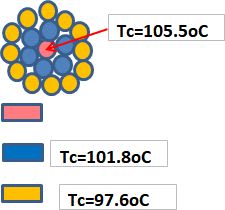At this plant site they replaced an oil filled transformer with a similar existing oil filled transformer 17/27MVA OAFA, 15kV-575V transformer.
It typically runs on the secondary side at 20,000 Amps per phase.
The new transformer had been previously connected by bus work between the transformer secondary bushings and the load, a rectifier. One bus per phase.
There are short pieces of braided copper between the two connections.
It's new location however required cabling instead of bus to be installed between the secondary bushings and it's load, a different rectifier.
The design called for DLO777 type cable because of the tight area and flexibility required. Ampacity 900Amps per phase if used in free air. So they used like 24 of these cables per phase.
When they did an infrared scan on the installation - one of the cables in the bundles had overheated - like up to 300 deg F. And then it spread over time to the other cables.
Why would only one cable do that ?
It typically runs on the secondary side at 20,000 Amps per phase.
The new transformer had been previously connected by bus work between the transformer secondary bushings and the load, a rectifier. One bus per phase.
There are short pieces of braided copper between the two connections.
It's new location however required cabling instead of bus to be installed between the secondary bushings and it's load, a different rectifier.
The design called for DLO777 type cable because of the tight area and flexibility required. Ampacity 900Amps per phase if used in free air. So they used like 24 of these cables per phase.
When they did an infrared scan on the installation - one of the cables in the bundles had overheated - like up to 300 deg F. And then it spread over time to the other cables.
Why would only one cable do that ?

